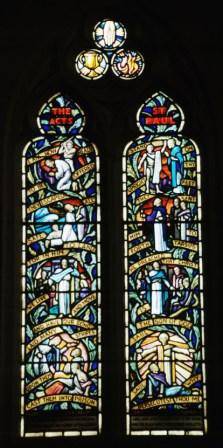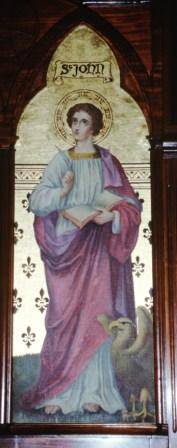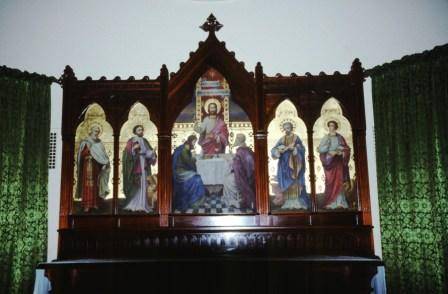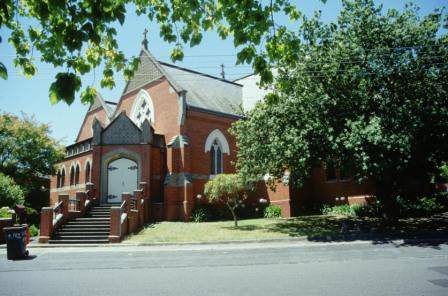| Back to search results » | Back to search page » |
|
Christian Waller Windows & William Montgomery Reredos - St. Paul's Anglican Church
LocationCnr Margaret & Church Streets,, CANTERBURY VIC 3126 - Property No B7326
File NumberB7326LevelState |
|
Statement of Significance
Two stained glass windows designed and made by Christian Waller (1892-1952) for St. Paul's Anglican Church, Canterbury: Christ the King of All Nations and The Life of St. Paul. The present brick building was designed by A.E. H. Carleton and erected in 1914, replacing a small wooden structure that was sold to St. Peter's, Murrumbeena. In 1931 the same architects prepared plans for the addition of choir and chancel, making provision for the Rose window, Christ the King of All Nations, the first figurative window to be installed in the church. The second window, The Life of St. Paul, was installed in the west wall of the north transept in 1952.
Why is it significant? The Christian Waller stained glass windows are significant for aesthetic. historic and social reasons at a State level.
How is it significant? Christian Waller's two windows at St. Paul's Anglican Church, Canterbury are significant for aesthetic reasons, exemplifying excellence in stained glass art and craftsmanship. The two windows show an imaginative use of subject and text that is unique among Australian stained glass artists and are appropriately integrated within the architectural and religious setting.
The windows are also historically important as they are among the best Modernist stained glass windows installed in a religious setting. The East Rose window, Christ, the King of All Nations, completed in 1932, was among her earliest works in this medium, and The Life of St. Paul is believed to be her last commission, exemplifying her consistent Modernist style over a twenty year period.
As gifts by, and memorials to, the Redman family, the windows have historical and social significance to the Church and its congregation. As a churchwarden and vestryman George Redman was involved in the erection and prominence of the Church, and was also respected as a local businessman in Canterbury and the surrounding district. Mrs. Redman, was a staunch member of St. Paul's, working and worshiping at the church for sixty years.
REREDOS:
What is significant? The reredos and series of five painted panels executed by William Montgomery (1850-1927) for St. Paul's Anglican Church, Canterbury: Supper at Emmaus and Ss. Matthew, Mark, Luke and John. The present brick building was designed by A.E.H. Carleton and erected in 1914, replacing a small wooden structure that was sold to St. Peter's, Murrumbeena. The reredos was installed after the completion of the new brick church in 1915 but it was the addition of five painted panels by January 1916 that were to add significantly to its acceptance by the congregation and its importance as an adjunct to worship.
Why is it significant? The reredos and series of five painted panels are significant for aesthetic and historic reasons at a State level.
How is it significant? The series of reredos panels is aesthetically and historically significant as the only intact surviving example of this aspect of the oeuvre of Melbourne stained glass artist, William Montgomery. The panels exemplify his artistic ability and are an appropriate adjunct to the church architecture and worship.
The reredos and series of panels are historically important as changes in liturgy since the 1960s have seen the removal of many such edifices from Anglican churches, and of the few that survive, most are marble or stone. It remains one of few examples of a simple timber reredos in a parish church.
Classified: 28/11/2005
Group
Religion
Category
Religious art







